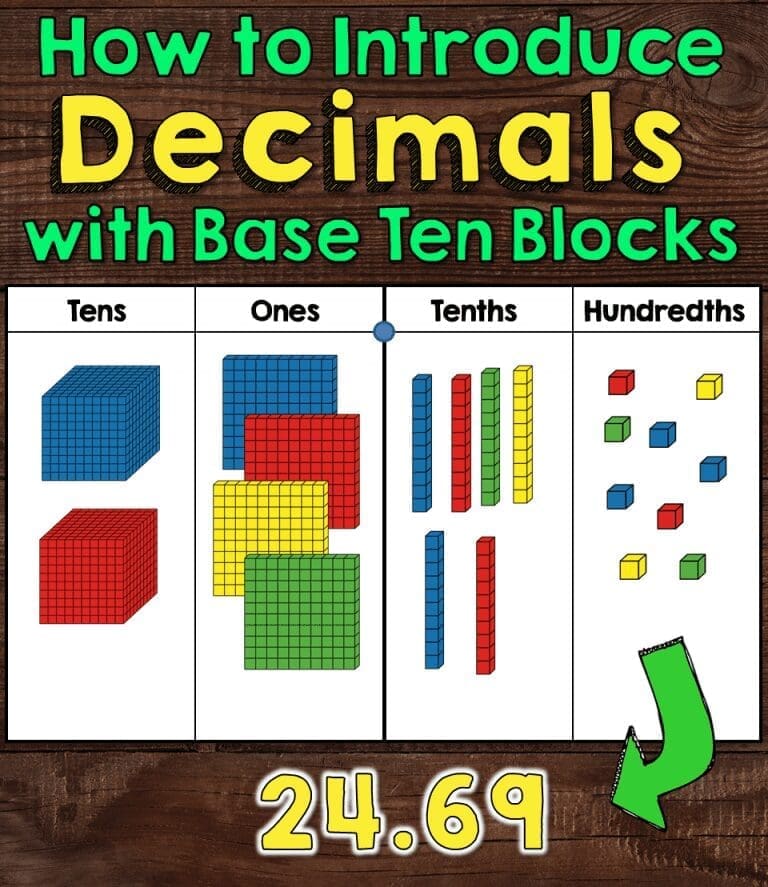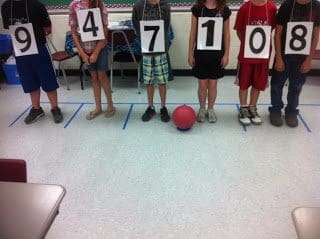If your students have a solid understanding of whole number place value being based on patterns of tens, and an understanding of fractions, learning decimal place value should be a natural progression. This post will mostly be on introducing decimals and decimal place value (4th grade standard) but does have some resources for 5th grade standards as well.
Manipulatives
Model, model, model. Use your manipulatives such as base 10 blocks, Cuisenaire Rods, or, best yet if you can get them, deci blocks. Be sure students understand in a hands on way how base 10 applies to decimals. You will be using the manipulatives again to demonstrate decimal operations, including addition, subtraction, multiplication and division, so take the time to make sure students understand. As Beyond Traditional Math puts it in their article “1 and 2 is NOT 12,” “it doesn’t occur to us to pull out tools, manipulatives or materials. Our young learners need this, as they are very concrete and it can help them make the connection to number sentences.So let them have those materials! Have them out for ALL students, so that no student ever feels “babyish” having to use them. This is essential for students to understand place value conceptually.”
Here are step by step instructions from Laura Candler on How To Introduce Decimals With Base 10 Blocks. The post also includes free printable mats and task cards.

Grids
After using physical manipulatives, you can use square grids for coloring models.
Here is a free printable PDF for decimal squares in wholes, tenths, hundredths, and thousandths.
Relationship Between Decimals and Fractions
This free lesson from The National Math and Science Initiative uses base 10 blocks and grids to introduce decimals by building upon what students already know about fractions. It also uses a Venn diagram to compare fractions and decimals.
Number Lines
Next, as always, USE THE NUMBER LINE. Probably the question I get the most from older kids struggling with math is “Why did no one ever show me this on a number line? It makes so much more sense!” However, using number lines is not just for struggling students. As the Elementary Math Maniac says, “Number lines are a great way to help kids think about ordering and comparing numbers. They also make a great conversation starter to talk with kids about the density of numbers. Asking questions such as “how many numbers are between 1.2 and 1.3″ get at the idea that the numbers are infinite.”
Here is a great article from The Elementary Math Maniac on Using Meter Sticks for a Decimal Number Line.
Math Geek Mama has a fantastic and FUN partner game for Decimals On a Number Line. She has three different game boards at different levels of difficulty.
Games For Practice
At Two Sisters Teach find instructions for this human place value chart game using a ball as a decimal point. She also has a Battleship game.

Place Value Yahtzee, linked in my earlier post on whole number place value, has an option for including decimals. My students LOVE this game.
However, my students’ all-time favorite decimal game is Marilyn Burns’ The Place Value Game. I introduce in small group, and then students can easily play on their own with partners and groups.
More Resources
Free printable decimal place value charts from Math Salamanders
Math Antics Video Decimal Place Value
Khan Academy Decimal Place Value (5th Grade)
Free Read, Write, Compare Decimals Task Cards for 5th grade standards
Teaching With a Mountain View has an excellent article on Decimal Place Value Resources and Teaching Ideas
